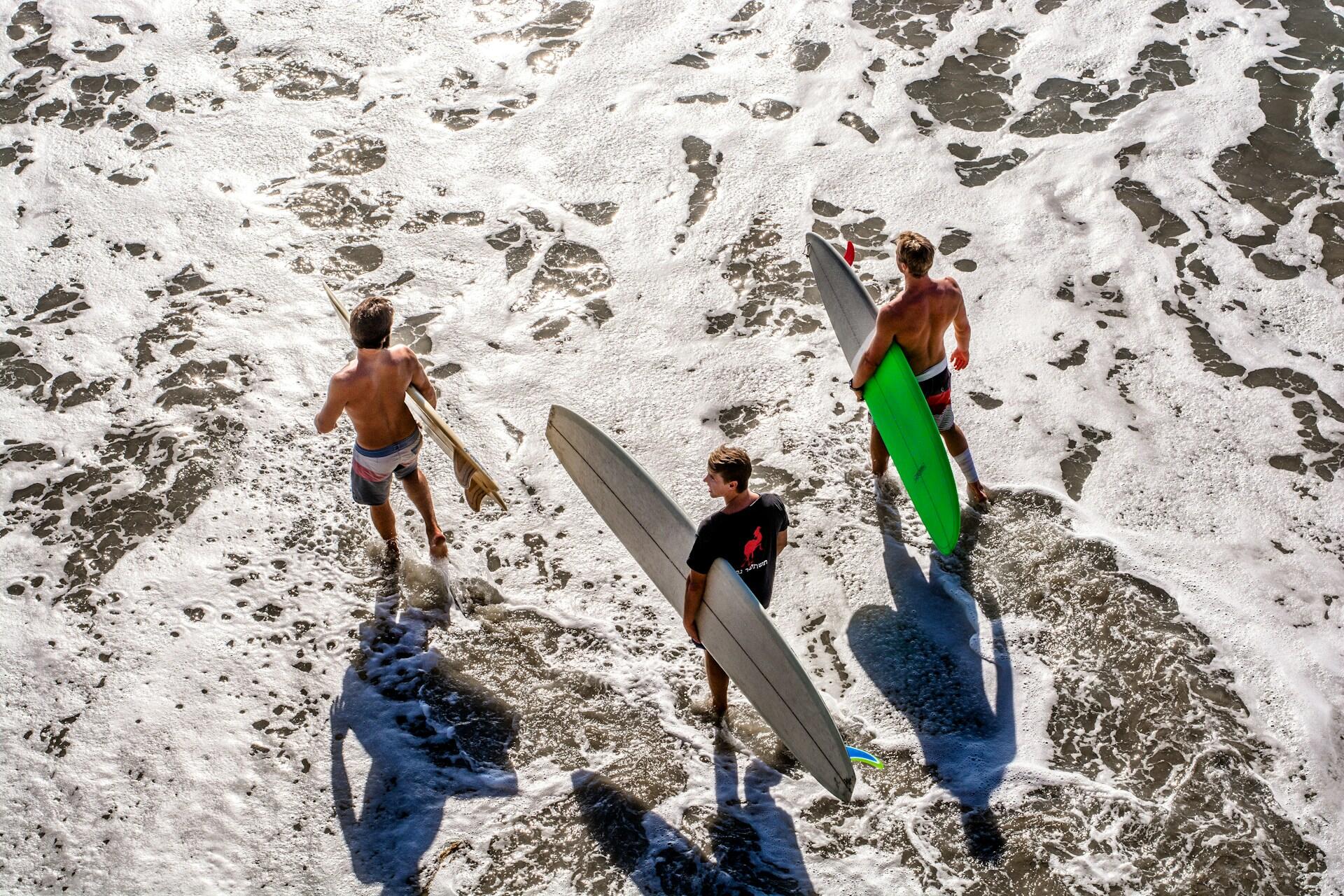It's very easy to get swept up in the technique when you're learning to surf. Still, for your own safety and the safety of others, you should be aware of surf etiquette. This is the set of unspoken surfing rules that allow surfers to share the lineup respectfully, avoid collisions, and have as much fun as possible. For beginner surfers, it's a good idea that you're aware of what's expected of you, especially if you're surfing somewhere that's rather busy.
| Rule 🌊 | Do ✅ | Don't 🚫 |
|---|---|---|
| Respect Right of Way / Priority | Let the surfer closest to the peak take the wave | Assume it’s yours because you paddled first |
| Don’t Drop In on Another Surfer | Look both ways before taking off | Take off on a wave someone else is already riding |
| Don’t Snake or Steal Waves | Wait your turn in the lineup | Paddle around others to get inside position |
| Paddle Wide and Avoid the Peak | Paddle out around the break and surfers | Paddle through the peak or rider’s path |
| Hold Onto Your Board | Wear a leash and keep your board under control | Let go of your board during wipeouts |
| Know Your Limits and Follow Safety Guidelines | Surf waves suited to your ability | Charge into big or dangerous conditions unprepared |
| Don’t Hog All the Waves | Share sets and allow others their turn | Catch every wave or dominate the lineup |
| Respect the Lineup and Take Turns | Watch, learn the flow, and take waves in order | Cut in or rush ahead of others in position |
| Respect Locals and the Break | Observe local habits and act with humility | Paddle straight to the peak or act entitled |
| Be Friendly, Communicate, and Help Others | Greet others, call directions, and offer help if needed | Stay silent, ignore others, or blame when mistakes happen |

Respect Right of Way / Priority
Who has the right to the wave is one of the most important rules when surfing nowadays. This is known as priority, and it's how the lineup stays organised and fair. The surfer closest to the peak of the wave (the part that breaks first) has priority. If somebody is already paddling into or riding that wave from the inside, then it's their wave.

As a beginner surfer, this can be pretty confusing at crowded breaks. It doesn't matter whether you were up first or if you've been waiting the longest; it's your position, rather than timing, that determines priority.
Do not paddle into a wave that somebody is already riding (or about to ride). At best, you'll only frustrate other surfers, but at worst, you could cause an accident. Take your time, sit off to the side of the lineup, watch how the wave works, and see how priority plays out in action. You'll learn to read the peak, anticipate movement, and take your turn. You'll learn about sharing waves rather than stealing them.
As a beginner, observe the lineup before jumping in. Watch how surfers rotate, who has priority, and when it’s your turn.
Don’t Drop In on Another Surfer
Dropping in is a common and frustrating breach of surfing etiquette often committed by new surfers. This is when you paddle into a wave that another surfer is already riding, usually from closer to the peak, cutting them off, ruining their ride, and potentially creating a dangerous situation. Before you can start enjoying the advantages of surfing, make sure you understand the rules!
Dropping in is like somebody swerving in front of you from the side of the road. It's a combination of poor manners and dangerous behaviour. Two surfboards colliding can cause serious injury to people. Even if they don't collide, someone having to bail mid-wave can also get hurt.
Beginner surfers might drop in because they didn't see the other surfer. However, it's still their responsibility to look both ways before taking off. Watch the lineup, check your shoulder, and ensure that the wave is yours. If in doubt, back off.
We recommend counting to three and doing a quick scan before popping up. If someone is already riding or clearly paddling into the wave from the inside, you'll have to leave it. There'll be more waves, so respect priority and avoid drop-ins. It'll keep the surfing experience fun for everyone.
before dropping in.
Don’t Snake or Steal Waves
Snaking is a pretty sneaky move. This is when a surfer paddles around another person to get closer to the peak, taking priority unfairly. It's a way to steal a wave without breaking the drop-in rule, but it's often seen as disrespectful and best avoided.
A beginner surfer mightn't mean to snake, but impact is more important than intent. Paddling aggressively around somebody who's already in position is just greedy and dishonest. It can ruin the flow of the lineup. Be patient. Give those already waiting in position the space and the wave. Paddle calmly, watch the set, and respect others' positions.
If someone snakes you, let it go. Paddle back out and follow the surfing code of conduct. Lead by example even when others don't.
Paddle Wide and Avoid the Peak
How you paddle is a huge part of good surf etiquette. Paddling straight through the peak is the kind of mistake that a beginner surfer might make. Doing this puts you directly in someone's path and increases the risk of collisions or ruined rides.
Paddle wide instead of heading directly through the breaking zone. Take a longer route around the shoulder or the side of the wave where nobody is riding. This can take more time and effort, but it's a respectful approach that keeps you out of the way of the surfers still in the lineup.
If you get caught on the inside and someone's coming towards you, don't panic! Paddle toward the whitewater, not toward the open face of the wave. It can prevent you from ruining someone else's ride.


Hold Onto Your Board
A simple rule: never let go of your surfboard in the water unless you absolutely have to. A loose board can become a dangerous projectile. It's key to surfing safety guidelines regardless of the different surfing disciplines you could choose to do.
After a wipeout or during a dick dive, beginner surfers might throw their board away to protect themselves. This can be risky since a surfboard on a wave, no person can slam into someone paddling out, ruin a ride, or cause serious injury.
Wearing a leash is essential. This keeps your board close and under control. However, you still need to practise safe dismounts, learn how to turtle roll or duck dive, and be aware of who's around you.
If you're surfing in busy spots, consider your board as an extension of you. Keep it under control at all times, respecting the water.
They can cause serious injury if you lose control of them.
Know Your Limits and Follow Surfing Safety Guidelines
Surfing is a lot of fun. However, it can quickly become dangerous if you don't understand your skill level. A beginner surfer should choose the right conditions and waves according to their ability.
Skip sessions when the waves are too big or when the current is too strong. The same is true if the lineup is too crowded. You can check the forecast and ensure you're always realistic.
If you're not a confident swimmer or unfamiliar with the break, consider taking a lesson or watching from the beach to learn. By protecting yourself, you're also looking out for others in the water at the same time. The ocean doesn't care how good you think you are. Be humble, stay aware, and always surf within your ability.
Don’t Hog All the Waves
One of the biggest unspoken rules in surf etiquette is not to be a wave hog. The lineup works best when everyone gets a fair go. If you're paddling for every set and not letting others take turns, you'll quickly irritate the other surfers.
Beginner surfers or those less skilled will wear out their welcome if they keep taking waves. The best surfers share waves, and the very best will even let a less experienced surfer learn rather than taking all the good waves for themselves.
Don't monopolise the break, just be mindful and think about whether you've already had a few. Surfing culture is built on generosity, not greed, and you'll receive more respect if you prioritise quality over quantity.

Respect the Lineup and Take Turns
Having understood priority, wave hogging, and the other rules, you should have a better understanding of how to navigate the lineup. The lineup is basically a queue that operates according to respect, awareness, and patience.
Don't head straight to the peak of the inside when you paddle out. Observe how the rotation works and gradually move into position. Taking turns is an essential part of the surfing code, and though it might be trickier in crowded conditions, look around. Treat the lineup with the same respect as you would anywhere else. There are no prizes for cutting, hovering, or rushing the queue.
Respect Locals and the Break
Remember that everything so far is part of a broader and unwritten surfing "etiquette". These aren't surfing "laws", per se, but rather cultural norms; surfing etiquette can differ from place to place, but the most common rules have likely been understood throughout the storied history of surfing.
Don't be intimidated by surfing in a new place, just be aware. Don't act like you own the place, especially if you've surfed it before. Humility can go a long way, and it's better to follow the example of the locals, especially in the lineup.

Be Friendly, Communicate, and Help Others
The best surfing is experienced when everybody's on the same page. Admittedly, it's easy to forget the etiquette when you're paddling, popping up, and trying not to fall of your board. However, surfing is a shared experience, and a little kindness goes a long way.
Try to communicate clearly and help others. You can push back someone's board when they lose it, give unsure beginner surfers some space and encouragement, and own it if you make a mistake. Surfers will be more likely to forgive you if they can see you're trying to follow the unwritten rules.















